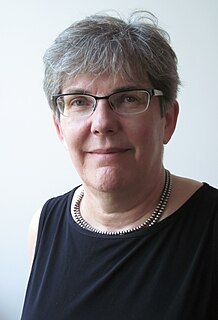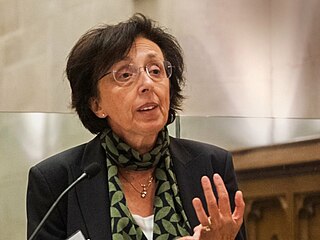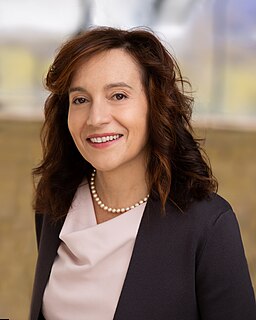Related Research Articles
Rodney Joseph Bartlett is Graduate Research Professor of Chemistry and Physics, University of Florida, Gainesville, USA.

Henry Frederick "Fritz" Schaefer III is a computational and theoretical chemist. He is one of the most highly cited chemists in the world, with a Thomson Reuters H-Index of 121 as of 2020. He is the Graham Perdue Professor of Chemistry and Director of the Center for Computational Chemistry at the University of Georgia.

Sir David Charles Clary, FRS is a British theoretical chemist. He was president of Magdalen College, Oxford, from 2005 to 2020. He was the first chief scientific adviser to the Foreign and Commonwealth Office from 2009 to 2013. He is a Professor of Chemistry at the University of Oxford.

Anna I. Krylov is a Professor of Chemistry at the University of Southern California (USC), working in the field of theoretical and computational quantum chemistry. She is the inventor of the spin-flip method. Krylov is the president of Q-Chem, Inc. and an elected member of the International Academy of Quantum Molecular Science and the Academia Europaea.
Steven R. White is a professor of physics at the University of California, Irvine. He graduated from the University of California, San Diego; he then received his Ph.D. at Cornell University, where he was a shared student with Kenneth Wilson and John Wilkins. He is most known for inventing the Density Matrix Renormalization Group (DMRG) in 1992. This is a numerical variational technique for high accuracy calculations of the low energy physics of quantum many-body systems. His over one hundred seventy papers on this and related subjects have been used and cited widely—his most cited article has received about four thousand citations.
James R. Heath is an American chemist and the president and professor of Institute of Systems Biology. Previous to this, he was the Elizabeth W. Gilloon Professor of Chemistry at the California Institute of Technology, after having moved from University of California Los Angeles.

Myriam Paula Sarachik was a Belgian-born American experimental physicist. From 1996, she was a distinguished professor of physics at the City College of New York.

Donald Gene Truhlar is an American scientist working in theoretical and computational chemistry and chemical physics with special emphases on quantum mechanics and chemical dynamics.
Gustavo E. Scuseria is the Robert A. Welch Professor of Chemistry, Professor of Physics & Astronomy and Professor of Materials Science & NanoEngineering at Rice University, Houston, TX. He is also editor-in-chief of the Journal of Chemical Theory and Computation. Scuseria earned his PhD from the University of Buenos Aires in 1983 and conducted post-doctoral work at the University of California, Berkeley (1985-1987) and the University of Georgia (1987-1989) prior to joining the chemistry faculty at Rice University in 1989.

Emily Ann Carter is the Executive Vice Chancellor and Provost at UCLA and a distinguished professor of chemical and biomolecular engineering. She served from 2016 to 2019 as Princeton's dean of engineering and applied science, before returning to UCLA as EVCP in September 2019. Carter developed her academic career at UCLA from 1988 to 2004, where she helped launch two institutes: the Institute for Pure and Applied Mathematics and the California NanoSystems Institute. Carter is a theorist and computational scientist whose work combines quantum mechanics, solid-state physics, and applied mathematics.

Heidi Marie Schellman is an American particle physicist at Oregon State University (OSU), where she heads the Department of Physics. She is an expert in Quantum chromodynamics.

Albert Stolow is a Canadian physicist. He is the Canada Research Chair in Molecular Photonics, Full Professor of Chemistry & Biomolecular Sciences and of Physics, and a Member of the Ottawa Institute for Systems Biology at the University of Ottawa. He is the founder and an ongoing member of the Molecular Photonics Group at the National Research Council of Canada. He is Adjunct Professor of Chemistry and of Physics at Queen's University in Kingston, and a Graduate Faculty Scholar in the Department of Physics, University of Central Florida and a Fellow of the Max-Planck-uOttawa Centre for Extreme and Quantum Photonics. In 2008, he was elected a Fellow in the American Physical Society, nominated by its Division of Chemical Physics in 2008, for contributions to ultrafast laser science as applied to molecular physics, including time-resolved studies of non-adiabatic dynamics in excited molecules, non-perturbative quantum control of molecular dynamics, and dynamics of polyatomic molecules in strong laser fields. In 2008, Stolow won the Keith Laidler Award of the Canadian Society for Chemistry, for a distinguished contribution to the field of physical chemistry, recognizing early career achievement. In 2009, he was elected a Fellow of the Optical Society of America for the application of ultrafast optical techniques to molecular dynamics and control, in particular, studies of molecules in strong laser fields and the development of new methods of optical quantum control. In 2013, he was awarded the Queen Elizabeth II Diamond Jubilee Medal (Canada). In 2017, Stolow was awarded the Earle K. Plyler Prize for Molecular Spectroscopy and Dynamics of the American Physical Society for the development of methods for probing and controlling ultrafast dynamics in polyatomic molecules, including time-resolved photoelectron spectroscopy and imaging, strong field molecular ionization, and dynamic Stark quantum control. In 2018, Stolow was awarded the John C. Polanyi Award of the Canadian Society for Chemistry “for excellence by a scientist carrying out research in Canada in physical, theoretical or computational chemistry or chemical physics”. In 2020, he became Chair of the Division of Chemical Physics of the American Physical Society. His group's research interests include ultrafast molecular dynamics and quantum control, time-resolved photoelectron spectroscopy and imaging, strong field & attosecond physics of polyatomic molecules, and coherent non-linear optical microscopy of live cells/tissues, materials and geological samples. In 2020, Stolow launched a major new high power ultrafast laser facility at the University of Ottawa producing high energy, phase-controlled few-cycle pulses of 2 micron wavelength at 10 kHz repetition rate. These are used for High Harmonic Generation to produce bright ultrafast Soft X-ray pulses for a new Ultrafast Xray Science Laboratory.
Annabella Selloni is the David B. Jones Professor of Chemistry at Princeton University.

Giulia Galli is a condensed-matter physicist. She is the Liew Family Professor of Electronic Structure and Simulations in the Pritzker School of Molecular Engineering and the Department of Chemistry at the University of Chicago and senior scientist at Argonne National Laboratory. She is also the director of the Midwest Integrated Center for Computational Materials. She is recognized for her contributions to the fields of computational condensed-matter, materials science, and nanoscience, most notably first principles simulations of materials and liquids, in particular materials for energy, properties of water, and excited state phenomena.

Paul Anthony Benioff is an American physicist who helped pioneer the field of quantum computing. Benioff is best known for his research in quantum information theory during the 1970s and 80s that demonstrated the theoretical possibility of quantum computers by describing the first quantum mechanical model of a computer. In this work, Benioff showed that a computer could operate under the laws of quantum mechanics by describing a Schrödinger equation description of Turing machines. Benioff's body of work in quantum information theory has continued on to the present day and has encompassed quantum computers, quantum robots, and the relationship between foundations in logic, math, and physics.
Katherine Birgitta Whaley is a Professor of Chemistry at the University of California Berkeley and a senior faculty scientist in the Division of Chemical Sciences at Lawrence Berkeley National Laboratory. At UC Berkeley, Whaley is the Director of the Berkeley Quantum Information and Computation Center, a member of the executive board for the Center for Quantum Coherent Science, and a member of the Kavli Energy Nanosciences Institute. At Lawrence Berkeley National Laboratory, Whaley is a member of the Quantum Algorithms Team for Chemical Sciences in the research area of resource-efficient algorithms.

Laura Gagliardi is an Italian theoretical and computational chemist and Richard and Kathy Leventhal Professor of Chemistry and Molecular Engineering at the University of Chicago. She is known for her work on the development of electronic structure methods and their use for understanding complex chemical systems.
Françoise Remacle is a Belgian theoretical physical chemist whose research topics have included fast time scales in chemistry, the chemical interactions of quantum dots, and DNA computing. She is a director of research for the Belgian National Fund for Scientific Research, and head of the Theoretical Physical Chemistry group at the University of Liège.
Gilda H. Loew was an American chemist known for applying computational chemistry to biology. She was elected a Fellow of the American Physical Society in 1975.
Deborah Kay Watson is an American physicist known for her work on the many-body problem in quantum mechanics. She is a professor emerita of physics at the University of Oklahoma.
References
- ↑ "Julia E. Rice", Researchers, IBM Research, retrieved 2021-12-17
- 1 2 3 "Julia Rice", Members, International Academy of Quantum Molecular Science, retrieved 2021-12-17
- ↑ "Fellows nominated in 2001 by the Division of Computational Physics", APS Fellows archive, American Physical Society, retrieved 2021-12-17